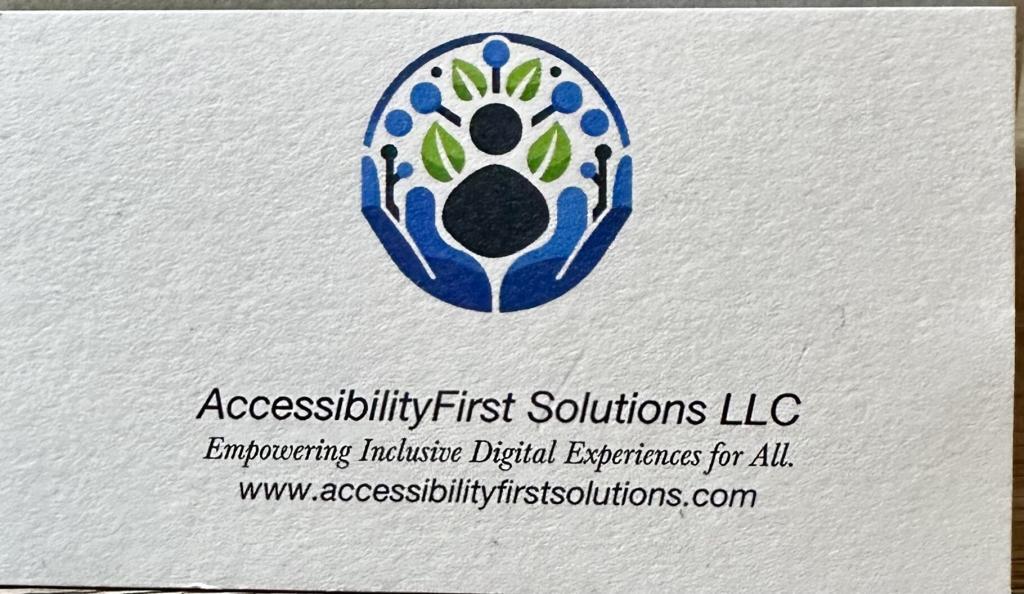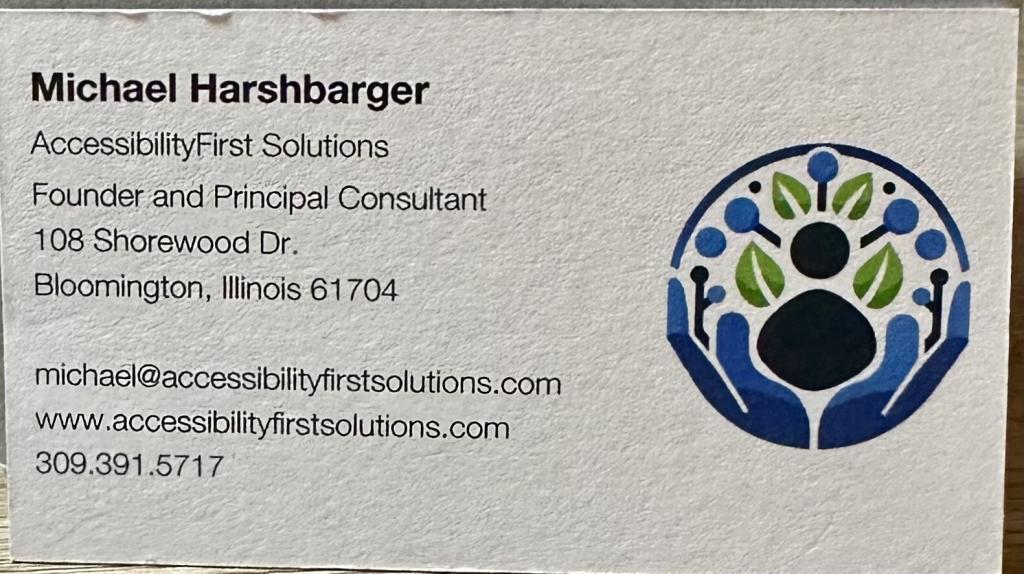As the founder of AccessibilityFirst Solutions LLC, I recently decided it was time to design new business cards. Business cards have long been a staple in the professional world, offering a convenient way to share contact information. However, as I began the ordering process, a thought struck me: business cards, by their very design, are inherently inaccessible to many people. This realization led me on a journey to transform a simple business card into an accessibility powerhouse.
The Traditional Business Card Dilemma
Business professionals have been using business cards for centuries, and for good reason. They are a fast and effective way to share information, establish credibility, and serve as a physical reminder of a connection made. Business cards in their traditional design are not accessible for people with visual impairments.
Because they are not accessible, does that mean we should not use business cards? Does this mean we should abandon business cards altogether? Absolutely not. Instead, we can think of ways to make them more accessible and inclusive. This journey led me to explore various methods to enhance the accessibility of my business cards.
Exploring Accessibility Options
One of the first solutions that came to mind was incorporating braille into my business cards. Braille can provide critical information to individuals who are blind or have low vision. However, upon further research, I discovered several limitations. Adding braille to business cards incurs additional costs and extends the production time by about two weeks. The size of braille characters limits the amount of information that can be included to just a name and a phone number. Also, the person receiving the card needs to read braille. Something many people can’t do.
Although braille is useful, and the business card might look cool with something a lot of people do not have exposure to, it did not meet my goal. My aim was to discover a solution that offers more information, unrestricted by limitations.
QR Codes: Enhancing Accessible Business Card Design
That is when I turned to a technology widely used across various industries: QR codes. Smartphones can easily scan QR codes to direct users to a website or download contact information. Incorporating QR codes into an accessible business card design, I could provide all the information electronically.
The benefits of QR codes extend beyond accessibility. For instance, I often discard business cards after saving the information. With a QR code, recipients can quickly scan and save my contact details, reducing the likelihood of losing the card or throwing it away. At conferences or networking events, it’s easy to run out of business cards. With a QR code, I can offer the code for scanning, ensuring that no one leaves without my contact information. These advantages show that making business cards accessible can enhance their functionality for everyone.
Improving Usability in Inclusive Business Card Design
To further improve the usability of my business cards, I borrowed an idea from the hospitality industry. Hotel key cards often have a corner cut to help guests orient the card correctly in dark hallways or when in a hurry. Inspired by this, I cut a corner on my business cards. By positioning the cut in the bottom left, anyone—regardless of their visual ability—can easily locate the QR code in the upper left corner. This simple modification ensures that the business card is user-friendly and accessible to all.




Drawing Parallels to Web Accessibility
This journey with my business cards got me thinking about web accessibility. Much like a business card, a webpage can have accessibility issues that hinder its usability for certain individuals. Like improving business cards, we can make small changes to enhance website accessibility without starting from scratch. Even simple changes can transform your site into an accessibility powerhouse. Making sure a keyboard can use your website or adding alternative text are changes you can make that make a big difference. Accessibility improvements are within everyone’s grasp.
Conclusion and Call to Action
Through this journey, I learned that making something accessible does not just benefit those with disabilities; it enhances the experience for everyone. By incorporating QR codes and a simple tactile indicator, my business cards are now more functional and inclusive. This experience has reinforced my commitment to accessibility and the belief that small changes can make a big difference.
I encourage you to reflect on this: Would you be able to add a QR code to your business card? Business cards usually have a blank back, or an open corner for code placement. Would you be willing to cut a corner to help someone? This minor modification does not change the overall design but makes it significantly more accessible.
Similarly, consider your website. Does it have accessibility issues? Could you fix them with a few small changes? The example of my business cards proves we can improve accessibility in a lot of cases without a total redesign.
Our commitment at AccessibilityFirst Solutions LLC is to assist businesses in creating accessible solutions that benefit everyone. If you are interested in learning more about how to make your business more accessible, contact us today and let us make a difference together. Our Accessibility Audits or Accessibility Training can start you on your journey to accessibility.

Michael Harshbarger is an experienced project manager and accessibility consultant. He is passionate about helping businesses create inclusive digital experiences. With over ten years of experience in project management and accessibility, Michael established AccessibilityFirst Solutions LLC. Michael believes in promoting accessibility as a core business value. He thinks that inclusive design benefits not only those with disabilities but also enhances the user experience for everyone. Michael holds a Master’s degree in Project Management. He has successfully implemented accessibility programs for Fortune 100 companies. In his free time, Michael enjoys exploring the outdoors with his family and playing tabletop role-playing games.
